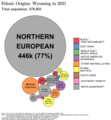The Wyoming PortalPanorama view of Devils Tower, located in the Bear Lodge Ranger District of the Black Hills, near Hulett and Sundance in Crook County, northeastern Wyoming (2021)
 Wyoming (/waɪˈoʊmɪŋ/ ⓘ wye-OH-ming) is a landlocked state in the Mountain West subregion of the Western United States. It borders Montana to the north and northwest, South Dakota and Nebraska to the east, Idaho to the west, Utah to the southwest, and Colorado to the south. With a population of 576,851 in 2020, Wyoming is the least populous state despite being the 10th largest by area, with the second-lowest population density after Alaska. The state capital and most populous city is Cheyenne, which had an estimated population of 63,957 in 2018. Wyoming's western half consists mostly of the ranges and rangelands of the Rocky Mountains; its eastern half consists of high-elevation prairie, and is referred to as the High Plains. Wyoming's climate is semi-arid in some parts and continental in others, making it drier and windier overall than other states, with greater temperature extremes. The federal government owns just under half of Wyoming's land, generally protecting it for public uses. The state ranks sixth in the amount of land—and fifth in the proportion of its land—that is owned by the federal government. Its federal lands include two national parks (Grand Teton and Yellowstone), two national recreation areas, two national monuments, and several national forests, as well as historic sites, fish hatcheries, and wildlife refuges. Indigenous peoples inhabited the region for thousands of years. Historic and currently federally recognized tribes include the Arapaho, Crow, Lakota, and Shoshone. Part of the land that is now Wyoming came under American sovereignty via the Louisiana Purchase, part via the Oregon Treaty, and, lastly, via the Mexican Cession. With the opening of the Oregon Trail, the Mormon Trail, and the California Trail, vast numbers of pioneers travelled through parts of the state that had once been traversed mainly by fur trappers, and this spurred the establishment of forts, such as Fort Laramie, that today serve as population centers. The Transcontinental Railroad supplanted the wagon trails in 1867 with a route through southern Wyoming, bringing new settlers and the establishment of founding towns, including the state capital of Cheyenne. On March 27, 1890, Wyoming became the union's 44th state. (Full article...) Selected article -The Treaty of Fort Laramie (also the Sioux Treaty of 1868) is an agreement between the United States and the Oglala, Miniconjou, and Brulé bands of Lakota people, Yanktonai Dakota, and Arapaho Nation, following the failure of the first Fort Laramie treaty, signed in 1851. The treaty is divided into 17 articles. It established the Great Sioux Reservation including ownership of the Black Hills, and set aside additional lands as "unceded Indian territory" in the areas of South Dakota, Wyoming, Nebraska, and possibly Montana. It established that the US government would hold authority to punish not only white settlers who committed crimes against the tribes but also tribe members who committed crimes and were to be delivered to the government, rather than to face charges in tribal courts. It stipulated that the government would abandon forts along the Bozeman Trail and included a number of provisions designed to encourage a transition to farming and to move the tribes "closer to the white man's way of life." The treaty protected specified rights of third parties not partaking in the negotiations and effectively ended Red Cloud's War. That provision did not include the Ponca, who were not a party to the treaty and so had no opportunity to object when the American treaty negotiators “inadvertently” broke a separate treaty with the Ponca by unlawfully selling the entirety of the Ponca Reservation to the Lakota, pursuant to Article II of this treaty. The United States never intervened to return the Ponca land. Instead, the Lakota claimed the Ponca land as their own and set about attacking and demanding tribute from the Ponca until 1876, when US President Ulysses S. Grant chose to resolve the situation by unilaterally ordering the Ponca removed to the Indian Territory. The removal, known as the Ponca Trail of Tears, was carried out by force the following year and resulted in over 200 deaths. (Full article...)CategoriesGeneral images -The following are images from various Wyoming-related articles on Wikipedia.
Did you know -
TopicsLargest citiesThe State of Wyoming has 99 incorporated municipalities.
New articlesThis list was generated from these rules. Questions and feedback are always welcome! The search is being run daily with the most recent ~14 days of results. Note: Some articles may not be relevant to this project.
Rules | Match log | Results page (for watching) | Last updated: 2024-04-14 00:06 (UTC) Note: The list display can now be customized by each user. See List display personalization for details.
Related portalsWikiProjectsAssociated WikimediaThe following Wikimedia Foundation sister projects provide more on this subject:
Sources
Discover Wikipedia using portals |





























































